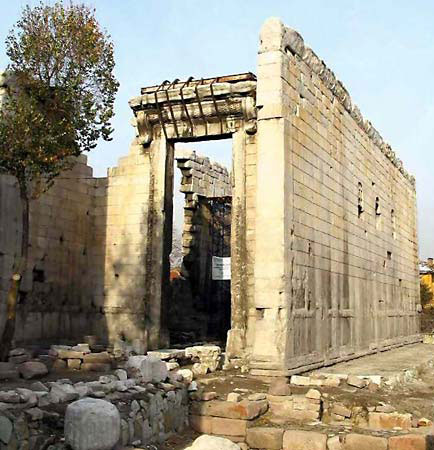
Featured Object: Plaster Cast of Roman Res Gestae, Latin Inscription, Second Panel
- Post Date: 06/30/2016
- Author: Andrew Truty
- Reading Time: 3 minute read
This cast of the Res Gestae Divi Augusti (The Achievements of the Divine Augustus), 1 of 6 in the Spurlock Museum’s collection, shows part of the title and text of the literary legacy left to the Roman world by its first emperor, Augustus, who reigned from 27 BCE to 14 CE. In the Res Gestae, Augustus details many of the deeds he performed on behalf of the Roman Senate and people, as well as various honors he received from them in return for these deeds. The accomplishments and achievements are drawn largely from the traditional spheres in which the Roman aristocratic male moved: political, religious, and martial. Accumulated acts in these 3 fields increased the prestige and auctoritas—an informal power, translated as perhaps “influence” rather than “authority”—of a noble within the intensely competitive Roman society. The deeds recounted in the Res Gestae can be seen as Augustus’s own account of how he came to occupy the leading position at Rome.
The Res Gestae was one of numerous documents accompanying his will that Augustus had released upon his death. In this document, Augustus requested that the Res Gestae be inscribed upon 2 large bronze pillars erected before his family. It is also conceivable that he hoped it would lend support to the hereditary succession he had striven to establish for his family before his death. These successors would later be known to history as the Julio-Claudian emperors, Rome’s first imperial dynasty. This house, though relatively short-lived, included such illustrious and notorious emperors as Tiberius, Gaius (Caligula), Claudius, and Nero.
Monument of Ancyra
The pillars at Rome on which the original copy of Res Gestae was inscribed has not survived. However, after his death, Augustus was declared a god. A cult dedicated to him, joined with a personified Rome, spread throughout the Roman provinces. At least at some of the temples consecrated to this cult, copies of the Res Gestae were set up in Augustus’s honor. Fortunately for later generations, one of these temples, along with both its Latin and Greek inscription of the Res Gestae, survived largely intact. This temple is today known as the Monument of Ancyra, due to its location in Ankara, the modern-day capital of Turkey. The Latin inscription is written on 6 columns, 3 to either side of the temple’s inner walls opposite the entrance. The larger lettered titular inscription runs across the top of the leftward columns. The Greek inscription is written on the outer side of the temple. Throughout time, houses have been built against the temple’s exterior walls, with the result that the Greek inscription is much more difficult to access and read.
The Monument of Ancyra first became known to Europe in the 16th century. Subsequently, many travelers, explorers, and diplomats transcribed the entire Latin inscription and as much of the Greek one as possible. However, they made no plaster casts. Finally, in 1882, under the auspices of the Berlin Academy, and at the instigation of the great classical scholar Theodor Mommsen, a commission was formed to make casts of both inscriptions in their entirety. This project resulted in over 200 plaster casts. The 6 casts in the Spurlock’s collection most likely derive from these Berlin Academy of Sciences casts made over a century ago, which are now maintained by the Pergamon Museum in Berlin.
-
- Share: 𝕏
- Subscribe to Newletter
- Giving
